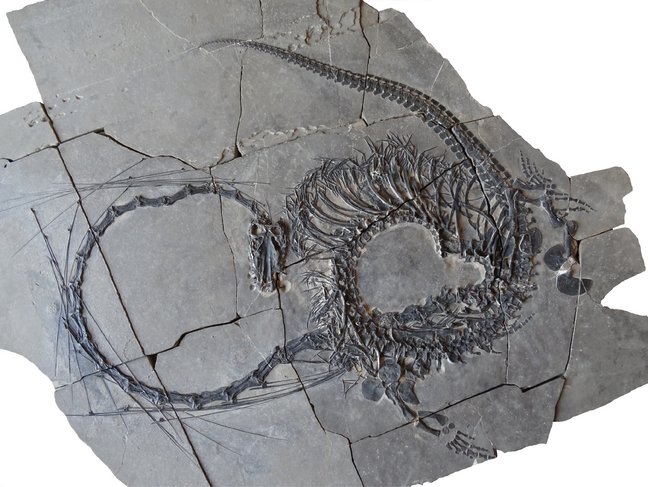Stuttgart, 23.02.2024. An international team of scientists from China, the USA and Europe, including Dr. Stephan Spiekman, paleontologist at the State Museum of Natural History Stuttgart, has studied new fossils of the marine reptile Dinocephalosaurus orientalis. This research has made it possible to fully describe the bizarre, very impressive animal for the first time. Dinocephalosaurus orientalis had an unusually long neck and reminded the researchers of the snake-like representation of dragons in Chinese mythology. The research findings on Dinocephalosaurus orientalis have now been published in the journal "Earth and Environmental Science Transactions of the Royal Society of Edinburgh" - just in time for the beginning of the Chinese Year of the Dragon.
In 2003, a skull and the first three cervical vertebrae of Dinocephalosaurus orientalis were uncovered and examined in the Guanling Formation of Guizhou Province. Since then, a number of other specimens have been discovered in southwestern China, which are now housed at the Institute of Vertebrate Paleontology and Paleoanthropology in Beijing and the Zhejiang Museum of Natural History in Hangzhou. These finds have enabled researchers from Scotland, Germany, the USA and China to describe virtually the complete skeleton of this marine reptile in a study conducted over a period of ten years.
"The discovery of the additional fossils allows us to see this remarkable long-necked animal in its entirety for the first time. It is reminiscent of the long, snake-like, mythical Chinese dragon. We are sure that Dinocephalosaurus orientalis will capture the imagination around the world because of its striking appearance," said Dr. Nick Fraser of the National Museum of Scotland, one of the authors of the study.
With 32 separate cervical vertebrae, Dinocephalosaurus orientalis did indeed have an exceptionally long neck. This suggests a comparison with Tanystropheus hydroides. Tanystropheus was found in both Europe and China during the Middle Triassic period. Both reptiles were of similar size and share several features of the skull, including a fish cage-like dentition.
"Dinocephalosaurus is unique in that it has many more vertebrae in both its neck and trunk than Tanystropheus. Dinocephalosaurus was viviparous (meaning it gave birth to live young rather than laying eggs) and obviously very well adapted to an oceanic lifestyle, as the fin limbs and the excellently preserved fish in its stomach area show," says Dr. Stephan Spiekman, specialist on long-necked marine reptiles at the State Museum of Natural History Stuttgart.
Despite superficial similarities, Dinocephalosaurus was not closely related to the famous plesiosaurs, which evolved around 40 million years later and served as the inspiration for the Loch Ness Monster.
"This was an international effort. In collaboration with colleagues from the United States of America and Europe, we used newly discovered specimens to expand our previous knowledge of Dinocephalosaurus. Among all the extraordinary Triassic finds we have made in Guizhou Province, this marine reptile probably stands out as the most remarkable," said Dr. Li Chun, author of the study and curator at the Institute of Vertebrate Paleontology and Paleoanthropology in Beijing.
The scientists hope to gain more insights into the evolution of this group of animals through further investigations in the future. In particular about the exact function of the long neck in marine reptiles.
For the editors
Original publication:
Stephan Spiekman, Wei Wang, Lijun Zhao, Olivier Rieppel, Nicholas C. Fraser and Chun Li: Dinocephalosaurus orientalis Li, 2003: A remarkable marine archosauromorph from the Middle Triassic of southwestern China. Earth and Environmental Science Transactions of the Royal Society of Edinburgh.
DOI: https://doi.org/10.1017/S175569102400001X
Publication date: 23.02.2024
Image material:
Image 1: Dinocephalosaurus fossil_Copyright_N. Fraser.jpg
Description: Dinocephalosaurus fossil (Institute of Vertebrate Paleontology and Paleoanthropology, Chinese Academy of Sciences, Beijing).
Author's note/copyright: Nicholas C. Fraser
Image 2: Reconstruction_Dinocephalosaurus orientalis_Copyright_M.Donelly.jpg
Description: Artist Marlene Donelly has created a lifelike illustration of Dinocephalosaurus orientalis swimming alongside a prehistoric fish called Saurichthys.
Author's note/copyright: Marlene Donelly
Please note that use of the image material is only permitted with a copyright notice. Thank you very much.
Contact:
Dr. Stephan Spiekman
State Museum of Natural History Stuttgart, Germany
Phone: +49(0)711/89 36/170
E-mail: stephan.spiekman(at)smns-bw.de
Dr. Stephan Spiekman is at your disposal for further information and interviews.
Press contact:
Meike Rech
State Museum of Natural History Stuttgart, Germany
Phone +49(0)711/8936/107
E-mail: meike.rech(at)smns-bw.de
Liliana Reinöhl
State Museum of Natural History Stuttgart, Germany
Phone +49(0)711/8936/106
E-mail: liliana.reinoehl(at)smns-bw.de
